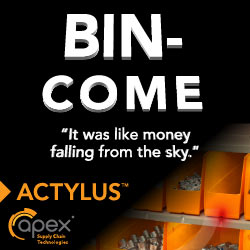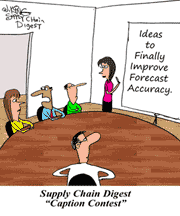Trip Report - Gartner Supply Chain Executive Conference Part 2
OK, I am back here after a two week gap while attending to other supply chain matters with part 2 of my trip report on the Gartner Supply Chain Executive conference in early May, as usual in Scottsdale, AZ. As such, Gartner is continuing the tradition of AMR Research, which began the event in the late 1990s before being acquired by Gartner in 2009, a move which took the event to whole new levels based on Gartner's superior marketing might.
You can find part 1 here, which focused on highlights from two days of keynote presentations. As promised then, here in part 2 I will summarize key breakout sessions. As noted in part 1, in my opinion the keynotes were down a bit in quality versus the past few years, while the breakouts were superior to what I saw in 2014 and 2015.
| GILMORE SAYS: |
With increasingly connected executives, it is highly likely that without such a system, the first time a supply chain executive hears of an issue say in Thailand could be in a call from the CEO, asking "What do we know?" and "How impacted are we?"
WHAT DO YOU SAY?
Send us your
Feedback here
|
Not necessarily the best but for sure the most interesting breakout session was from Gartner analysts Kamala Raman and Paul Lord. The session was titled "Taking a Comprehensive Approach to Supply Chain Cost Reduction," but what it really was about was defining a nascent model for organizing supply chain costs.
The proposed model has three main buckets:
1. Structural costs: Those costs largely "baked in" to a supply chain based on the current network design and product portfolio (e.g., the more SKUs, all things being equal, will drive more cost than fewer SKUs, plus how complex is the product design).
2. Operating efficiency: Basically, how a company is at the blocking and tackling of supply chain planning and execution.
3. What Gartner call "pricing waste," but which would be better called "input costs," and which has to do with how effectively a company procures materials and services.
I am not sure if this is good or not yet, but it got me thinking. For one, a sort of supply chain urban legend is that 85% of supply chain costs are locked in by a company's supply chain design (part of structural costs). I am pretty sure I know where this came from, which was a written piece by a consultant at what was then PRTM in Boston, and which was submitted with zero support to back it up. Nevertheless the idea has stayed a supply chain axiom of sorts even if that percentage was actually made up.
Gartner's operating efficiency bucket also recalls the writing I did last year on the "efficiency frontier," a fancier sounding name I first heard from Logility's Sean Willems to describe supply chain tradeoff curves. This is relevant because in terms of operating efficiency, the first question to ask is if a company is actually on its best tradeoff curve (say service versus cost), or is it far away from it due to inefficiencies. The next question, if you are operating your true curve, is can the entire curve be moved through innovation in process or technology (that is, maintaining or improving service while simultaneously reducing cost).
So, a lot to think about here, both at Gartner and at SCDigest, and more from us at least soon on this. On the product portfolio side, Gartner said computer maker Lenovo has developed a "rigorous" analytic model to calculate the costs of product portfolio decisions, which I would assume would include estimating cost changes for adding/reducing SKUs, using or not common parts, etc. Such a model would indeed be very useful.
The next most interesting session was actually a lunch discussion sponsored by innovative risk management solution provider Resilinc, moderated by ex-GM supply chain executive Bill Hurles, with panelists Lou Ferretti of IBM and Lee Young of Thermo Fisher Scientific.
In a pretty crowded room, I learned one important thing: near real-time "event detection" - notification of events from the realms of politics, natural disasters, weather, supplier failures and more - is at the top of the supply chain risk management priority list right now for many companies. And the reasons why are interesting.
 First, with increasingly connected executives, it is highly likely that without such a system, the first time a supply chain executive hears of an issue say in Thailand could be in a call from the CEO, asking "What do we know?" and "How impacted are we?" It is good to have answers to those CEO questions, and I believe it was Young who relayed a story of that happening when he did not know the answers, nor could he offer any new information in a short period of time. Talk about supply chain risk. First, with increasingly connected executives, it is highly likely that without such a system, the first time a supply chain executive hears of an issue say in Thailand could be in a call from the CEO, asking "What do we know?" and "How impacted are we?" It is good to have answers to those CEO questions, and I believe it was Young who relayed a story of that happening when he did not know the answers, nor could he offer any new information in a short period of time. Talk about supply chain risk.
Second, there is growing understanding that the company which responds fastest to an important disruption, such as by securing additional inventory/capacity from an alternative source, may escape relatively unscathed by a major event, whereas slow movers take a big hit. (There was also a side discussion on suppliers increasingly realizing this scenario, and therefore being slow to commit while await how demand plays out, often hiking prices dramatically.) But in general, there is a supply chain risk management arms race to be the first to know and respond to each event.
Young said Thermo Fisher typically tracks 40-50 events per week that have to be considered in some way. Everyone is struggling with mapping tier 2-4 suppliers to know how a disruption at some company you didn't even know was part of your supply chain may have an important impact. Young said Thermo Fisher can only really actively track about a fifth of even its direct vendors, and suggested that for suppliers with which a company spends a small amount of money but which could impact production if supply was constrained, it makes a lot of sense to simply bulk up on reserve inventory.
My next favorite was a session from Gartner's Greg Aimi and Rob Coyle of GlaxoSmithKline on "elevating the role" of outsourced logistics.
Aimi noted companies continue to maintain or increase their level of outsourcing, but are looking to do so with fewer 3PL partners. As more is outsourced, a company's skill in "orchestrating" a portfolio of 3PL providers becomes a key determinant of overall supply chain success. So the question is: how good is your company at this?
And portfolio is really the right way to think about it. Some 3PLs can be true strategic partners, with which so-called "vested" relationships might even be appropriate. Some 3PL relationships on the other hand will be purely transactional, and others somewhere in between.
Supplier segmentation in terms of appropriate effort, investment and relationship building is a popular concept overall in procurement, and it seems should also be applied to logistics outsourcing.
GSK's Coyle described the healthcare giant's move to creating a "lead logistics provider" arrangement, the path to which involved realizing that logistics was not a core competency at Glaxo - understandably a tough pill to swallow for many GSK logistics managers and something that had to be managed.
One important message from Coyle is that once a decision is made to really go whole hog into outsourcing logistics, there can be a lot of pressure from senior management to get it done quickly. Coyle said one of his biggest value-adds at GSK was to resist that pressure, taking the time to find a 4PL with the right strategic and cultural fit, as he believes that is absolutely the key to major outsourcing success.
GSK is moving down the path to complete transparency, where 3PLs contracted by the lead provider (a unit of Germany's Kuehne + Nagel) will simply have a fixed mark-up to GSK above those 3PL prices. Coyle also said it is a mistake to develop almost exactly parallel org structures between shipper and lead provider, as some companies have done - that just leads to extra cost and redundancy. Better to map out complementary roles and ensure the real value of each spot.
I also saw a decent presentation from Gartner's Matthew Spooner on improving accountability in S&P, which was distinguished by his list of the three reasons why demand planning should never be managed by the sales organization.
Those are: (1) significant upward bias to the final sales forecast, as much as 25% - it's more like 10% or less bias when supply chain owns demand planning; (2) the end demand plan also tends to be biased towards high levels of customer service, at the risk of excess inventory; and (3) sales is clearly lousy at dealing with product lifecycle management and new product introduction issues, and will fight to keep almost any SKU from being killed off.
Again, all told pretty good breakout this year. I am off to the LLamasoft user conference in New Orleans next week. Will produce a similar trip report from that event, and if you see me there please say hello.
Any reaction to our summary of Gartner 2016 breakout sessions? How would you define a supply chain cost structure? Let us know your thoughts at the Feedback section below.
|










 First, with increasingly connected executives, it is highly likely that without such a system, the first time a supply chain executive hears of an issue say in Thailand could be in a call from the CEO, asking "What do we know?" and "How impacted are we?" It is good to have answers to those CEO questions, and I believe it was Young who relayed a story of that happening when he did not know the answers, nor could he offer any new information in a short period of time. Talk about supply chain risk.
First, with increasingly connected executives, it is highly likely that without such a system, the first time a supply chain executive hears of an issue say in Thailand could be in a call from the CEO, asking "What do we know?" and "How impacted are we?" It is good to have answers to those CEO questions, and I believe it was Young who relayed a story of that happening when he did not know the answers, nor could he offer any new information in a short period of time. Talk about supply chain risk. 

